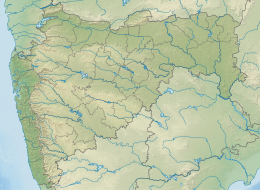This article needs additional citations for verification. (September 2016) |
| UTC time | 1993-09-29 22:25:48 |
|---|---|
| ISC event | 210578 |
| USGS-ANSS | ComCat |
| Local date | 30 September 1993 |
| Local time | 03:56 |
| Magnitude | 6.2 Mw[1] 6.3 Ms[2] |
| Depth | 10 km (6.2 mi)[1] |
| Epicenter | 18°04′N 76°37′E / 18.07°N 76.62°E[1] |
| Type | Reverse[3] |
| Areas affected | India |
| Total damage | $280 million–1.3 billion[3] |
| Max. intensity | MMI VIII (Severe)[4] MSK-64 VIII (Damaging)[5] |
| Casualties | 9,748 dead[3] 30,000 injured[3] 1 million displaced[6] |
The 1993 Latur earthquake struck India at 3:56 am local time (UTC+05:30) on 30 September. The main area affected is the districts of Latur and Osmanabad, including the Ausa block of Latur and Omerga of Osmanabad in Maharashtra, Western India.[7] Fifty-two villages were demolished in the intraplate earthquake. It measured 6.2 on the moment magnitude scale, and approximately 10,000 people died,[8] whilst another 30,000 were injured. The earthquake's hypocenter was around 10 km deep – relatively shallow – allowing shock waves to cause more damage. It is considered the deadliest earthquake in the stable continental crust to have occurred in recorded history.[4]
Because the location does not lie on a plate boundary, there was some debate as to what caused the earthquake. The Indian sub-continent crumples as it pushes against Asia and pressure is released. It is possible that this pressure is released along fault lines. Another argument is that reservoir construction along the Terna was responsible for increasing pressure on fault lines. Killari,[9] where the epicenter of the quake is believed to have been, had a large crater, which remains in place to date.[10][11]
- ^ a b c Cite error: The named reference
ISC-GEMwas invoked but never defined (see the help page). - ^ "Event: MAHARASHTRA, INDIA". National Geophysical Data Center.
- ^ a b c d Cite error: The named reference
PAGER-CATwas invoked but never defined (see the help page). - ^ a b Cite error: The named reference
NGDCwas invoked but never defined (see the help page). - ^ Harsh Gupta; Bal Krishna Rastogi (1998). "An investigation into the Latur earthquake of September 29, 1993 in southern India". Tectonophysics. 287 (1): 299–318. Bibcode:1998Tectp.287..299G. doi:10.1016/S0040-1951(98)80075-9.
- ^ "overview of the maharashtra, india emergency earthquake rehabilitation program" (PDF). iitk.ac.in. Archived (PDF) from the original on 8 March 2022. Retrieved 15 March 2022.
- ^ "Earth Quake". Archived from the original on 9 February 2014. Retrieved 26 August 2014.
- ^ Somasekhar, M. (1 October 2019). "26 years on, the Latur quake has taught us many lessons". Business Line. Chennai. Retrieved 20 October 2021.
- ^ "Latur earthquake 1993: September 30, a 'black day' for quake survivors in Maharashtra's Killari village – The Financial Express". The Financial Express. 26 September 2018. Retrieved 20 October 2021.
- ^ "PHOTOS : किल्लारी भूकंप, २३ वर्षांनंतरही जखमा अजून ओल्या". divyamarathi (in Marathi). Retrieved 13 September 2018.
- ^ "Maharashtra's deadliest earthquake: Some facts you must know about the Latur earthquake". India Today. Retrieved 13 September 2018.


